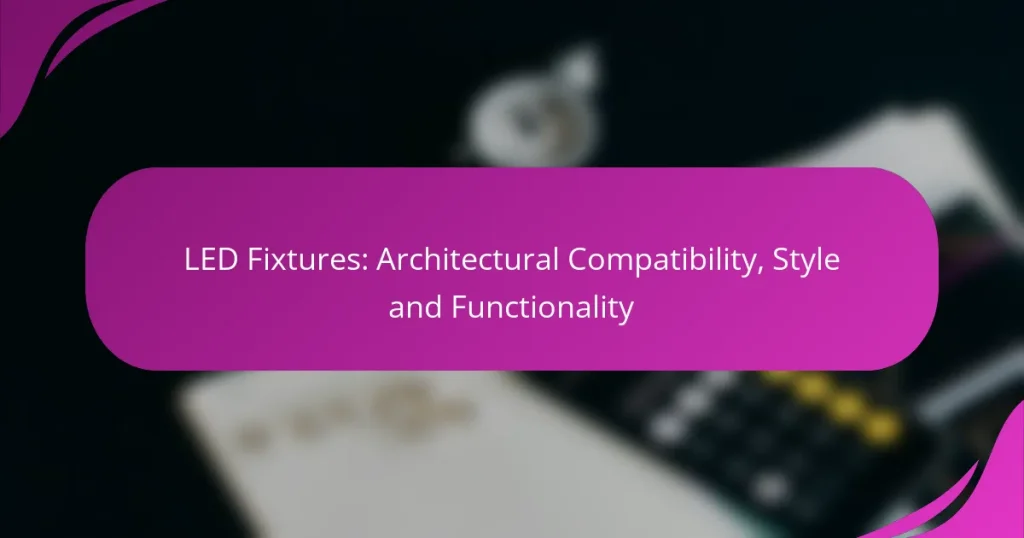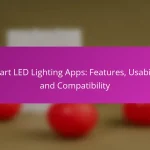LED fixtures play a crucial role in enhancing architectural compatibility by offering energy-efficient lighting solutions that seamlessly blend with both contemporary and historical designs. Their versatility allows for a wide range of styles, from minimalist to industrial, ensuring that lighting enhances rather than detracts from the overall aesthetic. Additionally, these fixtures improve functionality in commercial spaces, reducing energy costs while creating environments that promote productivity and safety.
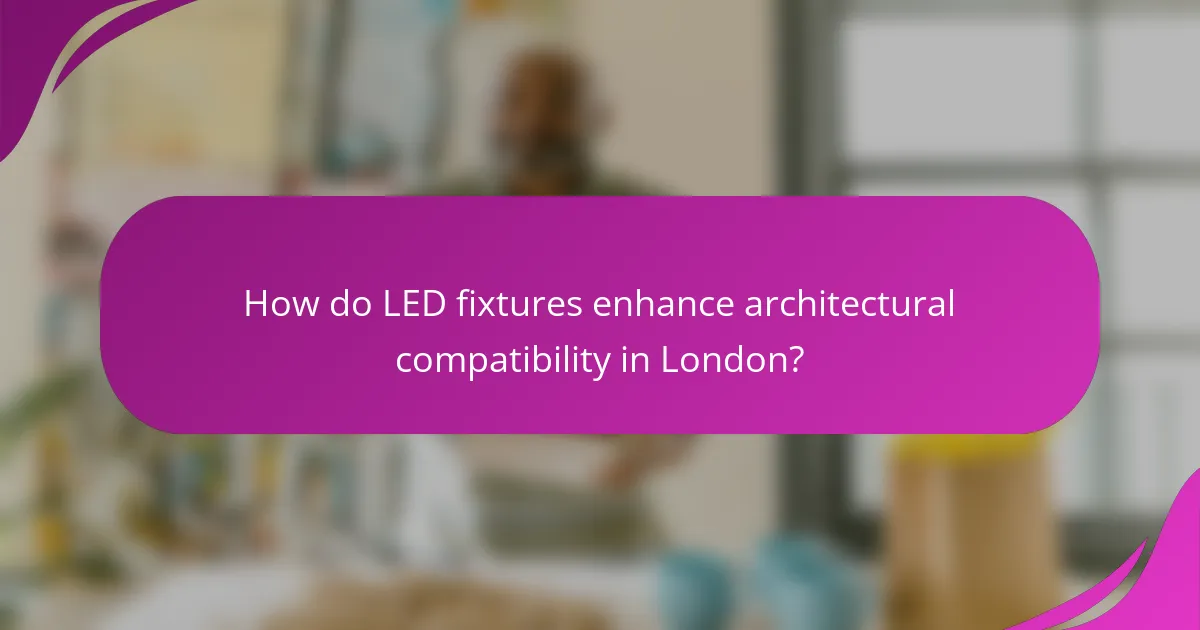
How do LED fixtures enhance architectural compatibility in London?
LED fixtures enhance architectural compatibility in London by providing energy-efficient lighting solutions that align with both modern and historical aesthetics. Their versatility allows for integration into various architectural styles, ensuring that lighting complements the overall design without overwhelming it.
Seamless integration with modern designs
LED fixtures are designed to blend effortlessly with contemporary architecture, featuring sleek lines and minimalistic profiles. This compatibility allows architects and designers to incorporate lighting as a key element of the overall aesthetic, enhancing the visual appeal of modern buildings.
For instance, recessed LED lighting can be installed in ceilings and walls, creating a clean look that highlights architectural features without being intrusive. Options like adjustable track lighting can also be used to accentuate specific areas or artworks within a space.
Support for historical building preservation
In London, preserving the character of historical buildings is crucial, and LED fixtures can play a significant role in this effort. These lights can be designed to mimic traditional lighting styles while offering modern efficiency and longevity.
Using LED fixtures that resemble vintage designs helps maintain the integrity of historical structures. Additionally, many LED options are available in warm color temperatures, which can replicate the ambiance of older incandescent bulbs, ensuring that new installations do not detract from the building’s historical significance.
Versatile mounting options
LED fixtures offer a range of mounting options that cater to diverse architectural needs, making them suitable for various settings in London. From surface-mounted to pendant and wall-mounted fixtures, the adaptability of LED lighting allows for creative solutions in both residential and commercial spaces.
When selecting mounting options, consider the height and layout of the space. For example, pendant lights can provide focused illumination over dining areas, while wall sconces can enhance corridors and entryways, ensuring that every area is well-lit and inviting.
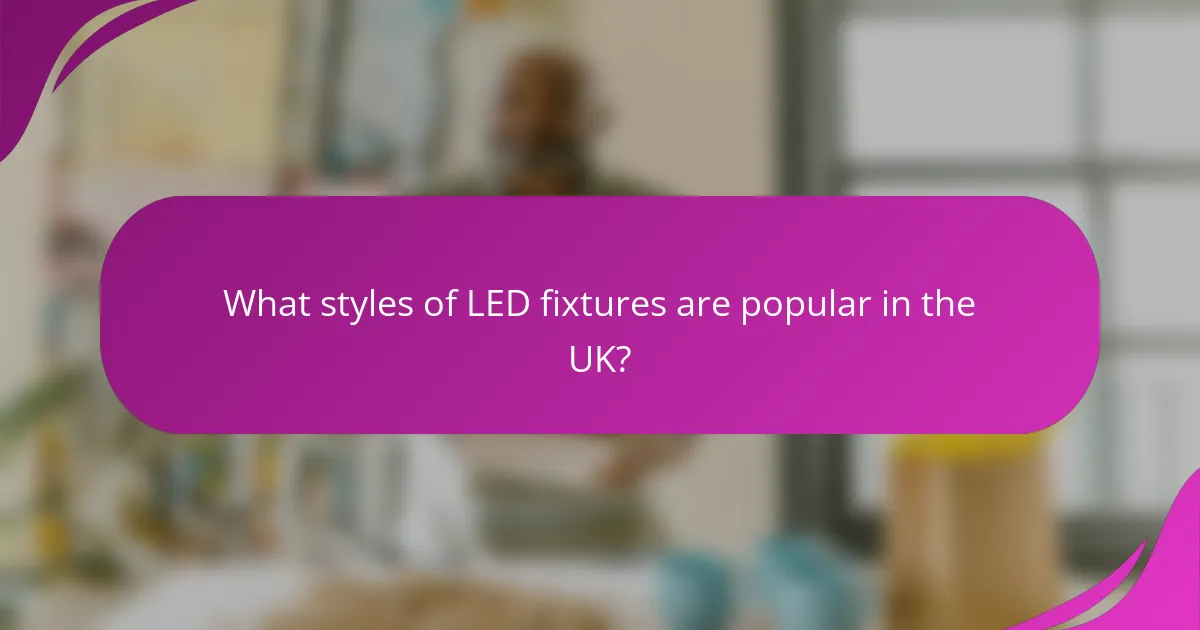
What styles of LED fixtures are popular in the UK?
In the UK, popular styles of LED fixtures include minimalist designs, industrial-style fixtures, and smart lighting solutions. These styles cater to various aesthetic preferences while providing energy efficiency and functionality.
Minimalist designs
Minimalist LED fixtures emphasize simplicity and clean lines, making them ideal for modern interiors. They often feature neutral colors and unobtrusive shapes, allowing them to blend seamlessly into any space.
When choosing minimalist fixtures, consider options like recessed lighting or slim pendant lights that provide illumination without overwhelming the decor. This style is particularly effective in open-plan living areas and contemporary office spaces.
Industrial-style fixtures
Industrial-style LED fixtures draw inspiration from warehouses and factories, showcasing raw materials like metal and exposed bulbs. This style adds character and a rustic charm to both residential and commercial environments.
Look for fixtures with a vintage finish or those that incorporate elements like Edison bulbs. They work well in loft apartments, cafes, and restaurants, creating a warm and inviting atmosphere.
Smart lighting solutions
Smart LED fixtures offer advanced features such as remote control, dimming options, and color-changing capabilities. These fixtures can be integrated with home automation systems, enhancing convenience and energy management.
Consider investing in smart bulbs or fixtures that allow for app control and voice commands. This technology is particularly beneficial for homeowners looking to create customizable lighting scenes or improve energy efficiency in their homes.
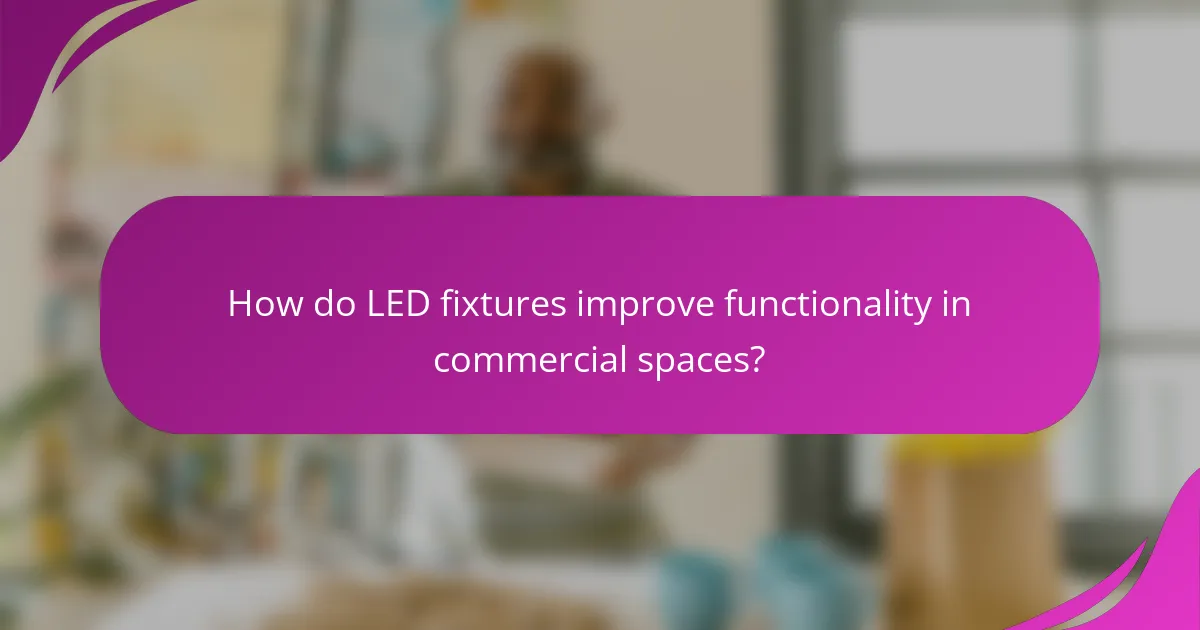
How do LED fixtures improve functionality in commercial spaces?
LED fixtures enhance functionality in commercial spaces by providing efficient, versatile, and effective lighting solutions. They not only reduce energy costs but also improve the overall environment, making spaces more conducive to productivity and safety.
Energy efficiency benefits
LED fixtures are significantly more energy-efficient than traditional lighting options, consuming up to 80% less energy. This efficiency translates into lower electricity bills, which can be particularly beneficial for businesses operating in large commercial spaces.
Moreover, many regions offer incentives for businesses that adopt energy-efficient technologies, making the initial investment in LED fixtures more financially attractive. Over time, the cost savings can offset the purchase and installation expenses.
Enhanced visibility and safety
LED lighting provides bright, clear illumination that enhances visibility in commercial environments, which is crucial for safety. Improved lighting reduces the risk of accidents and injuries by ensuring that walkways, staircases, and work areas are well-lit.
Additionally, LED fixtures can be designed to minimize glare and shadows, creating a more comfortable atmosphere for employees and customers alike. This can lead to increased productivity and a more positive experience in retail or office settings.
Customizable lighting solutions
LED fixtures offer a high degree of customization, allowing businesses to tailor lighting solutions to their specific needs. Options include adjustable brightness levels, color temperatures, and even smart controls that can be programmed for different times of day.
This flexibility enables businesses to create the ideal ambiance for various activities, whether it’s a bright, energizing environment for a busy office or a warm, inviting atmosphere for a retail space. Customizable solutions can enhance both functionality and aesthetics, making spaces more appealing to customers and employees.
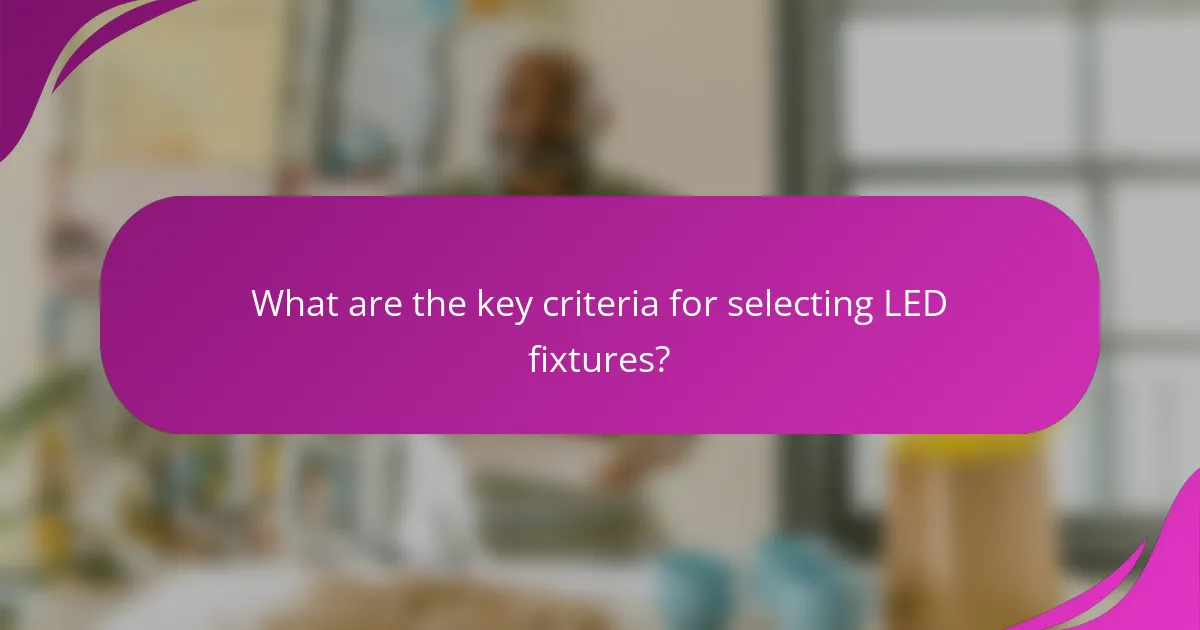
What are the key criteria for selecting LED fixtures?
When selecting LED fixtures, key criteria include compatibility with existing systems, light output and color temperature, and durability along with maintenance requirements. These factors ensure that the chosen fixtures meet both aesthetic and functional needs while integrating seamlessly into the intended environment.
Compatibility with existing systems
Compatibility with existing systems is crucial when choosing LED fixtures. Consider whether the new fixtures can work with current wiring, dimming controls, and other lighting elements. For instance, retrofitting LED bulbs into traditional fixtures may require adapters or specific types of drivers.
Check the voltage and wattage ratings of your current setup to avoid mismatches. Many LED fixtures operate on standard voltages, but some specialized systems may need specific configurations. Always consult product specifications to ensure a proper fit.
Light output and color temperature
Light output, measured in lumens, and color temperature, measured in Kelvin, are essential for achieving the desired ambiance. Higher lumen ratings indicate brighter light, which is important for functional areas like kitchens or workspaces. For general living areas, a moderate output may suffice.
Color temperature affects the mood of a space. Warmer temperatures (around 2700K-3000K) create a cozy atmosphere, while cooler temperatures (4000K-5000K) are more energizing and suitable for task-oriented environments. Consider the intended use of the space when selecting these parameters.
Durability and maintenance requirements
Durability is a significant factor in the longevity of LED fixtures. Look for products with high IP ratings, which indicate resistance to dust and moisture, especially in outdoor or high-humidity settings. A robust construction can reduce the frequency of replacements and repairs.
Maintenance requirements can vary widely among LED fixtures. Some may need occasional cleaning, while others are designed for minimal upkeep. Check the manufacturer’s guidelines for maintenance schedules and consider fixtures with longer warranties for added peace of mind.
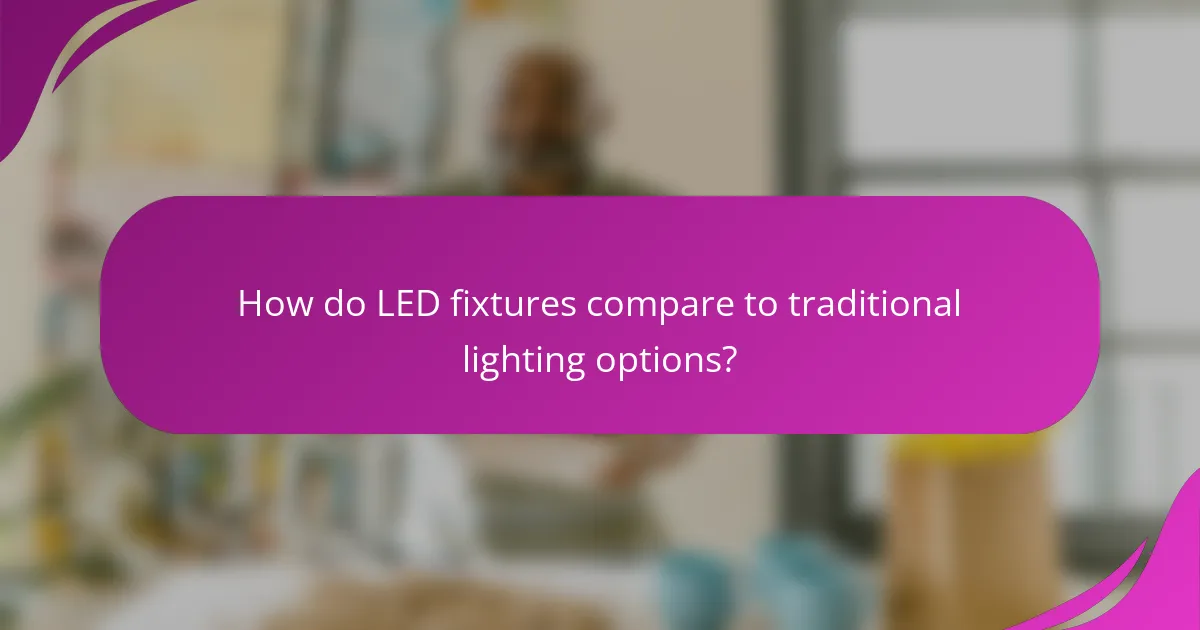
How do LED fixtures compare to traditional lighting options?
LED fixtures generally outperform traditional lighting options in terms of efficiency, cost savings, and environmental impact. They provide brighter illumination while consuming significantly less energy, making them a preferred choice for both residential and commercial applications.
Cost-effectiveness over time
LED fixtures are more cost-effective over their lifespan compared to traditional lighting. While the initial purchase price of LEDs may be higher, they consume less electricity and require less frequent replacements, leading to lower overall costs. For instance, switching to LED can reduce energy bills by up to 75% in some cases.
When considering installation, it’s important to factor in potential savings on labor and maintenance. LEDs typically last longer than incandescent or fluorescent bulbs, which means fewer replacements and less disruption.
Environmental impact
LED fixtures have a significantly lower environmental impact than traditional lighting options. They consume less power, which reduces greenhouse gas emissions associated with electricity production. Additionally, LEDs do not contain hazardous materials like mercury, commonly found in fluorescent lights, making them safer for disposal.
Using LED lighting can contribute to energy conservation efforts and help meet sustainability goals. Many regions offer incentives or rebates for switching to energy-efficient lighting, further promoting their adoption.
Longevity and reliability
LED fixtures are known for their longevity and reliability, often lasting up to 25,000 hours or more, compared to around 1,000 hours for incandescent bulbs. This extended lifespan means less frequent replacements, which is not only convenient but also reduces waste.
In addition to their long life, LEDs are more durable and resistant to shock and vibration, making them suitable for a variety of settings, including outdoor and industrial environments. This reliability ensures consistent performance and reduces the likelihood of sudden failures.
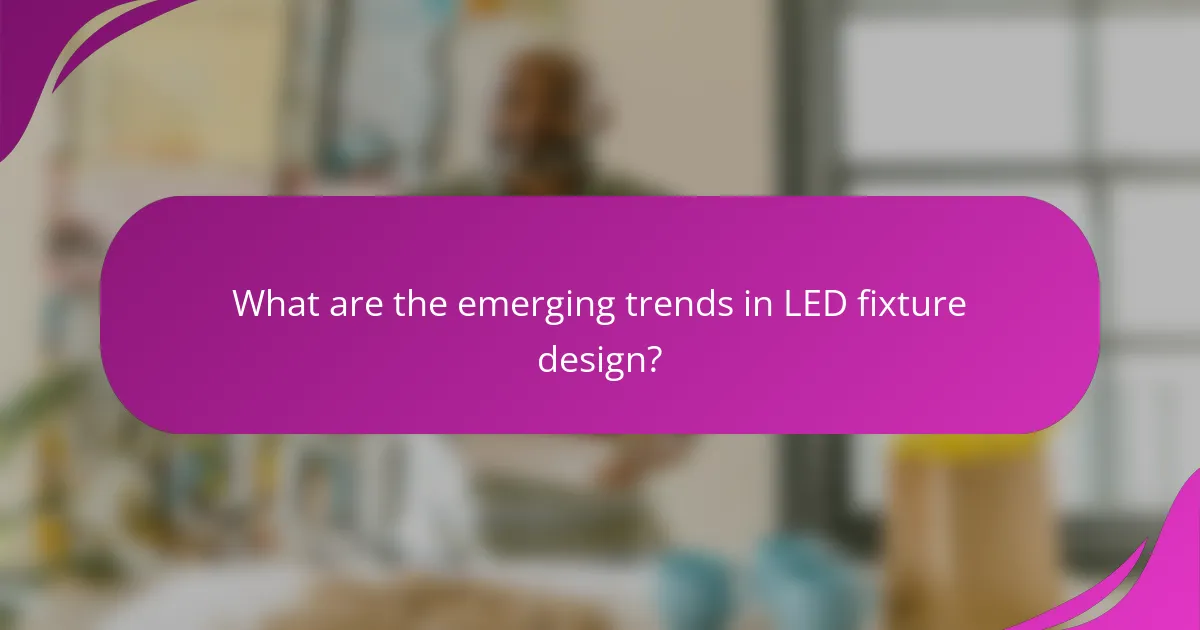
What are the emerging trends in LED fixture design?
Emerging trends in LED fixture design focus on enhancing functionality, aesthetics, and integration with smart technologies. Designers are increasingly prioritizing energy efficiency, adaptability, and user interaction to meet modern architectural needs.
Smart technology integration
Smart technology integration in LED fixtures allows for enhanced control and customization of lighting environments. This includes features like app-controlled dimming, color changes, and scheduling, which can significantly improve user experience and energy savings.
Consider fixtures that are compatible with popular smart home systems, such as Amazon Alexa or Google Assistant. This compatibility enables seamless integration into existing smart home ecosystems, allowing users to control lighting with voice commands or through mobile applications.
When selecting smart LED fixtures, look for those that offer energy monitoring capabilities. These features can help track energy consumption and identify opportunities for savings, making it easier to manage costs in the long run.
